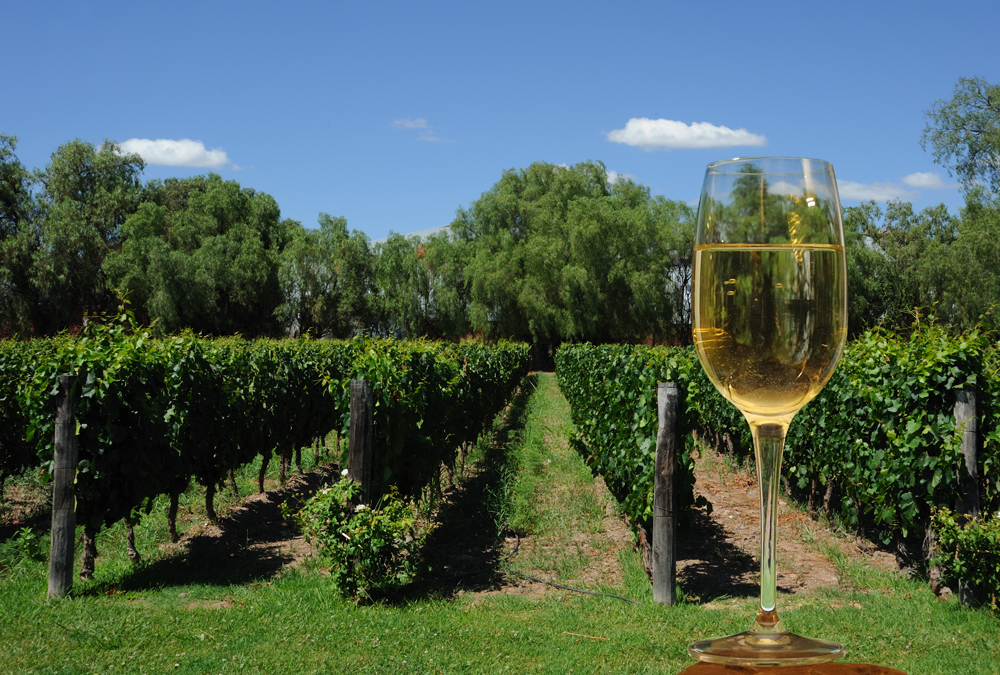
Video about Torrontés on my YouTube channel.
Torrontés is Argentina’s aromatic contribution to the world of white wines. Just as Malbec stands out as Argentina’s flagship red, Torrontés shines just as brightly among its whites.
To avoid confusion, let’s clarify: several grape varieties worldwide go by the name Torrontés. In Spain, for example, at least three local varieties are called Torrontés. However, these Spanish Torrontés varieties are genetically unrelated to the Argentine Torrontés and differ significantly in flavor.
Here, we’re specifically discussing the Argentine Torrontés.
In Argentina, three genetically related varieties fall under the Torrontés name: Torrontés Riojano, Torrontés Sanjuanino, and Torrontés Mendocino. They’re named after their provinces of origin—La Rioja, San Juan, and Mendoza, respectively. Torrontés Riojano and Torrontés Sanjuanino are hybrids of the ancient Muscat of Alexandria grape and the Spanish Criolla Chica, known as Mission in California and País in Chile. Torrontés Mendocino, on the other hand, is a cross between Muscat of Alexandria and another yet unidentified variety.
Torrontés originated in Argentina, where it quickly took root and spread thanks to its resilience to dry, hot conditions—a climate common in much of the country. However, while it could survive in such environments, thriving and producing high-quality fruit was a different matter. In the hot climate, Torrontés tends to produce high-alcohol, low-aroma, not-interesting wine. As a result, Torrontés played a minor role in Argentine vineyards for much of its history, with this trend persisting until the late 20th century.
In the 21st century, as global viticulture experienced a renaissance, Argentina was no exception. Winemakers began to reevaluate Torrontés, realizing its potential when grown under the right conditions. They started cultivating Torrontés in cooler, mountainous regions, and with attentive care, it transformed into a bright, aromatic, and refreshing wine that keeps gaining international popularity.
In my article on Pinot Noir, I explain that grape varieties generally fall into two broad categories: those that need cool climates to produce quality wine, and those that perform best in warm climates. Like Pinot Noir, Torrontés does not fare well in hot climates, where it loses acidity and aroma, resulting in a dull wine. On the other hand, a cool climate brings out the best in this grape.
Among the three Argentine Torrontés varieties, Torrontés Riojano is the most renowned and aromatic. In fact, the aroma of Torrontés Riojano from the high-altitude vineyards of Salta can even surpass that of Muscat and approach the intensity of Gewürztraminer. Today, it’s grown in much greater quantities than the other two varieties. When you see “Torrontés” on a bottle of Argentine wine without further specification, it’s almost always Torrontés Riojano. Torrontés Mendocino has a milder aroma, while Torrontés Sanjuanino falls somewhere in between.
Torrontés Riojano is grown in Salta, La Rioja, San Juan, and Mendoza. San Juan also grows Torrontés Sanjuanino, while the southern province of Rio Negro is dedicated to Torrontés Mendocino.
The best and most aromatic Torrontés comes from Salta, Argentina’s northern region known for its highest vineyards of the world. The Calchaquí Valley of Cafayate region is particularly renowned for its Torrontés vineyards, which are planted at altitudes reaching up to 3100 meters—over twice as high as Europe’s highest vineyards. In comparison, the highest vineyards in Switzerland and Spain’s Canary Islands reach around 1300-1400 meters. Cool nights help to preserve the grapes’ acidity, while abundant sunlight and poor soil enhance the concentration of aroma.
Torrontés from Mendoza, Argentina’s largest and most well-known wine region is not so bright as Salta’s, but quite descent. While Mendoza isn’t as high-altitude as Salta, it’s still situated in the mountains. The region includes the highest peaks in South America, and although vineyards here lie between 800–1,200 meters, they benefit from cooling winds off the nearby Andean glaciers. Mendoza also sits farther south than Salta, which, in the Southern Hemisphere, means a cooler climate. While not as cool as the high-altitude vineyards of Salta, Mendoza’s climate is still mild enough to preserve Torrontés’ essential acidity, with plenty of sun to intensify its aromas.
A quality Torrontés Riojano is typically medium-bodied, with refreshing medium acidity and an intense aroma dominated by floral, citrus, and white fruit notes. Despite its sweet aroma, Torrontés is usually a dry wine. Interestingly, Torrontés Mendocino and Torrontés Sanjuanino are often used for sweet wine production.
Torrontés is not suited for aging, as it loses its aromatic qualities quickly. It’s best to drink it young, ideally within the first year after release, and no later than three years. Argentina primarily produces pure varietal Torrontés wines, but it’s also commonly blended, often with Chardonnay.
Beyond Argentina, Torrontés is also grown in Bolivia and Chile, although in Chile, it is usually distilled into pisco. Speaking of pisco, it’s an interesting topic on its own.
Torrontés is best served well-chilled at 7–10°C. As a highly aromatic and dry wine, it pairs wonderfully with spicy cuisines, such as Indian or Asian dishes. It also complements white meats, cheeses (especially goat cheese), herbs, shrimp, and scallops.